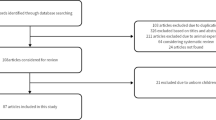Abstract
Objective
Mutation analysis in Indian children with achondroplasia.
Methods
We studied 11 sporadic cases of achondroplasia. Mutation analysis was done by PCR/RFLP (Polymerase chain reaction/Restriction fragment length polymorphism) method.
Results
Nine of the 11 cases had mutation G→A at 1138 nucleotide position in transmembrane domain of fibroblast growth-factor receptor 3 (FGFR3) gene. Substitution G→A is a common recurrent mutation reported worldwide. In two cases we could not detect any common mutation and also in entire region of transmembrane domain sequenced. There is possibility of mutation in the other regions of FGFR3 gene in these two cases.
Conclusion
Further study of these two cases is needed in order to define other genotypes resulting in achondroplasia. Postnatal diagnosis of achondroplasia depends on clinical and radiological features. Mutation detection is mainly useful for prenatal diagnosis.
Similar content being viewed by others
References
Francomano CA, Ortiz de Luna RI, Hefferon TW. Localization of the achondroplasia gene to the distal 2.5 Mb of human chromosome 4p. Hum Molec Genet 1994; 3: 787–792.
Le Merrer M, Rousseau F, Legeai-Mallet Laurence, Landias JC, Pelet A, Bonaventure J et al. A gene for achondroplasiahypochondroplasia maps to chromosome 4p. Nature Genet 1994; 6: 318.
Shiang R, Thompson LM, Zhu YZ, Church DM, Fielder TJ, Bocian M et al. Mutation in the transmembrane domain of FGFR3 cause the most common genetic form of dwarfism, achondroplasia. Cell 1994; 78: 335–342.
Health supervision for children with achondroplasia. American Academy of Pediatrics Committee on Genetics. Pediatrics 1995; 95: 443–445.
Bellu AG, Hefferon WT, Ortiz de Luna RI, Hecht TJ, Horton WA, Machado M et al. Achondroplasia is defined by recurrent G380R mutations of FGFR3. Am J Hum Genet 1995; 56: 368–373.
Camera G, Baldi M, Strisciuglio P, Concolino D, Masteroiacovo P, Baffico M. Occurrence of Thanatophoric dysplasia type I (R248C) and hypochondroplasia (N540K) mutation in to patients with achondroplasia phenotype. Am J Med Genet 2001; 104: 277–281.
Ikegawa S, Fukushima Y, Isomura M, Takada F, Nakamura Y. Mutations of fibroblast growth factor receptor-3 gene in one familial and six sporadic cases of achondroplasia in Japanese patients. Hum Genet 1995; 96: 309–311
Cohen MMJr. Some chondrodysplasias with short limbs: Molecular perspectives. Am J Med Genet 2002; 112: 304–313.
Mettler G, Fraser CF. Recurrence risk for sibs of children with “Sporadic” achondroplasia. Am J Med Genet 2000; 90: 250–251.
Modaff P, Horton K, Pauli RM. Error in the prenatal diagnosis of children with achondroplasia. Prenat Diagn 1996; 16: 525–530.
Gooding HC, Boehm K, Thompson RE, Hadley D, Francomano CA, Biesecker BB. Issues surrounding prenatal genetic testing for achondroplasia. Prenat Diagn 2002; 22: 933–940
Author information
Authors and Affiliations
Corresponding author
Rights and permissions
About this article
Cite this article
Patil, S., Banerjee, M., Phadke, S. et al. Mutation analysis in Indian children with achondroplasia — utility of molecular diagnosis. Indian J Pediatr 76, 147–149 (2009). https://doi.org/10.1007/s12098-009-0044-y
Received:
Accepted:
Published:
Issue Date:
DOI: https://doi.org/10.1007/s12098-009-0044-y




